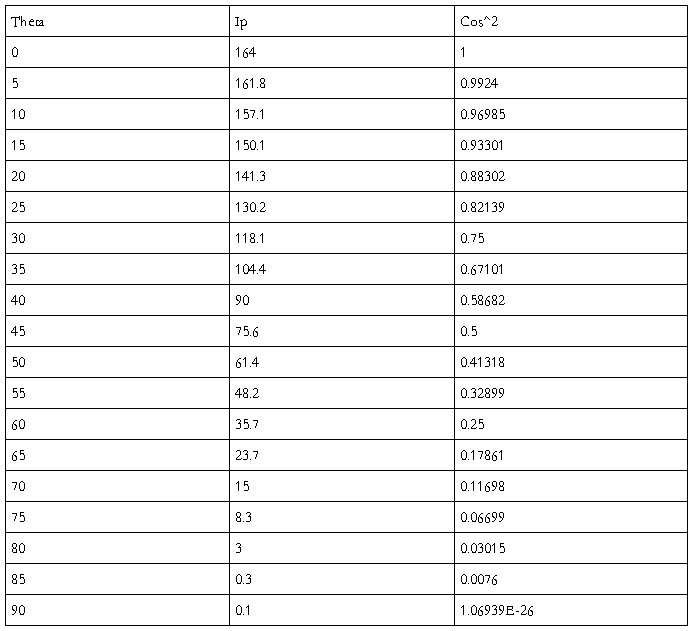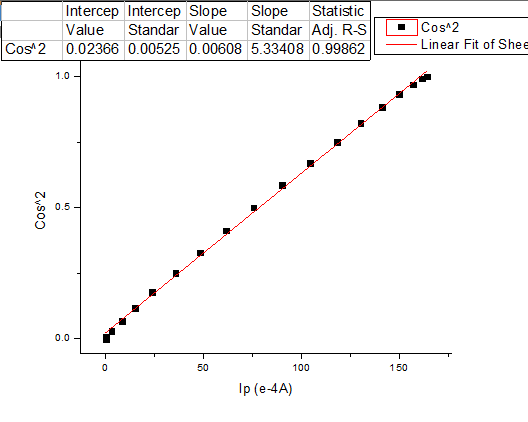polarized light
姓名: 班级 学号:
实验名称:偏振光的实验
The purpose of the experiment: to master the spectrometer works, familiar with the principles and properties of polarized light. Verify Malus law, and the refractive index of the medium is determined according to Brewster's law.
Experimental principle:
The various analyzes and measurements in order to study the polarization properties of the polarization state of light and the use of light, various polarizing element: generating a polarized light component, and to change the polarization state of the light elements, etc., the following classification introduced.
1..Produce polarized light components
Light generated from the laser before the invention, the natural light in general are non-polarized light, and therefore produce the components of the polarized light must produce polarized. Based on the role of these elements in the experiment were divided into a polarizer and an analyzer. The polarizer is an element which converts natural light into linearly polarized light, the analyzer is a polarization state of the element used to identify light. In the laser resonator can take advantage of the Brewster angle of the output laser beam is a linearly polarized light.
A lot of natural light becomes polarized, a method using light polarization phenomena in the interface reflection and transmission time. Our ancestors in the very early reflection of the horizontal plane light some research, but quantitative study was first performed in 1815 by Brewster. The reflected light perpendicular to the incident surface of the light vibration (called the s component) than parallel to the incident surface of the light vibration (called p component); while the transmitted light is opposite. Changing the incident angle at the time, there is a special phenomenon, i.e., when the incident angle of a specific value, the reflected light becomes completely linearly polarized light (s-component). Refracted light is partially polarized light, and at this time of the reflected light and refracted light vertical, a phenomenon known as Brewster's law. The method is one of the methods of the linearly polarized light can be obtained. As shown in Figure 1. Because this case,  ,
, ,
,
if n1 = 1 (for the refractive index of air), then  (1)
(1)
The Called the Brewster angle, so the refractive index of the medium can be measured by the size of the measurement of Brewster angle.
Called the Brewster angle, so the refractive index of the medium can be measured by the size of the measurement of Brewster angle.
Introduced above, we can know that the use of reflection can produce polarized light, the same can also take advantage of transmission (several transmission) to produce polarized light (glass heap). The second is an optical prism, a Nicol prism, a Glan prism, etc., it is birefringence using a crystal made of the principle. When there is a particular direction (optical axis direction) in the crystal, when the spread of the beam in this direction, the light beam does not split, the beam to deviate from the direction of propagation, the light beam will be split into two beams, wherein the light beam comply with the law of refraction called unusual light (o light), another beam of light is generally non-compliance with the law of refraction is called the extraordinary light (e light). O are linearly polarized light and e light (also called completely polarized light), both of the vibration direction of the light vector (in the normal use state) mutually perpendicular. Changing the direction of the incident light ray toward the crystals can be found in the optical axis direction, in this direction, the O ray and e-ray is equal to the velocity of propagation, the same refractive index. The crystals can have an optical axis, called uniaxial crystal, such as calcite, quartz, can have two optical axes, called biaxial crystal, such as mica, sulfur, etc.. Including the optical axis and the plane of each light line called corresponds to the main plane of the light, o photoelectric vector oscillation direction perpendicular to the main plane of o light, e photoelectric vector parallel to the vibration direction of the main plane of the e-ray.
Glan prism constituted by two calcite rectangular prism, the air gap, parallel to the optical axis of the calcite prism ridge between the two prisms. Natural light vertically the interface injection prism into o light and e light, o light in the air gap on total reflection, only e light through the prism.
The third is the polarizing plate, it is the use of polyvinyl alcohol made of a plastic film, it has a long chain of the comb-shaped structure of molecules, these molecules are arranged in parallel in the same direction, the film allows only perpendicular to the arrangement direction of the light vibrations is passed, resulting in linearly polarized light. Its polarization performance as a Glan prism, but the advantage is cheap, and a large area can be obtained. Polarizer as the polarizer and the analyzer used in this experiment.
2. Wave chip:
Also known phase retardation plate is to change the polarization state of light elements. It is a plane-parallel plate cut from a uniaxial crystal, due to the wave chip speed vo, ve different (so the refractive index is different), so the resulting o light and e is the light passes through the optical path of the wave wafer. The o light phase when the two beams through wave chip e light relative to the amount of delay, (2)
(2)
If  satisfied, that
satisfied, that  we call
we call  sheet, if
sheet, if  met, i.e
met, i.e ., we call the
., we call the sheet, if
sheet, if satisfied, i.e
satisfied, i.e . we call a full-wave plate (M is an integer).
. we call a full-wave plate (M is an integer).
Wave chip can be used to test and change the light polarization state, as shown in Figure 4, after the polarizer plus a wave plate, rotating the polarizer or wave plate can be obtained park or elliptical polarized light [details and methods see Document 2,3]. Wave plate is an the ellipsometer important element the ellipsometer can accurately measure the thickness and refractive index of the film, and precision instruments used in materials science.
The polarized light from Malus law, Malus law is the most basic and most important laws polarization. Marius discovered in 1809, completely linearly polarized light through the analyzer strong can be expressed as (3)
(3)
Wherein E is the angle of the direction of polarization of the analyzer and the polarization direction of the polarizer.
Experimental apparatus:
1, a semiconductor laser (wavelength 650nm), a polarizer 3, the analyzer 4, the spectrometer, and digital galvanometer.
Experimental procedures and data processing and analysis:
1, the instrument adjustment:
(1) First, the two-plane mirror adjust discharge of the semiconductor laser light tube (hereinafter referred to as the tube 1) it is perpendicular to the rotary spindle of the instrument (ie parallel to the plane) and dial, while the spectrometer table and dial plane parallel.
(2) check whether the output signal with digital galvanometer connected to the switch of the galvanometer measurement process to select a file on a file, adjust the zero knob, so that the data show "- .000" (minus sign flashing).
2, measuring the degree of polarization of the semiconductor laser
Polarizer P1 put in tube 1 hit 4th gear range selector 4 stages switch (from the vertical direction of the polarizer will be transferred to 0 ?), rotating polarizer find the intensity, the strongest position to record angle and light intensity value Imax. Then, the polarizer is rotated 90 ?, record the angle and light intensity value Imin. Calculated according to the formula degree of polarization of the laser beam P: (4)
(4)
Imin = 1.2 Imax = 145.9
By (4) can be calculated was:
P = 0.983
3, verify Malus law
The galvanometer is still in 4 files do not shift during the measurement. The polarizer on the light intensity and the strongest position analyzer P2 put on the other end the tube 2 and the vertical direction is 0 ?. Then rotating analyzer P2 the galvanometer light intensity minimum (still in 4th gear can be adjusted to 0). The angle between P1 and P2 are the direction of polarization can be considered at this time for of 90 ? recording P2 polarization direction at this time the absolute angle value ?, the value of the relative angle ? and light intensity value I, after every 10 ? records once, until P1 and P2 the angle between the direction of polarization of -90 ?, I0 is the angle between the polarization direction of the P1 and P2 for the light intensity values ??at 0 ? made I/I0 ? cos2 ? curve (0 ? ? 90 ? 0 ? ? - 90 ? each one, find the slope and intercept of the least squares method, according to the Malus law slope should be 1, the intercept should be 0, the analysis of the experimental error).
1) -90~0

Origin linear the contemplated merger analysis error:

2) 0~90

Origin linear the contemplated merger analysis error:

4, the measurement of the Brewster angle:

Δθ=56º21’≈57º And theoretically in line with
